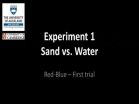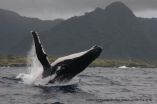(Press-News.org) VIDEO:
This video shows example trials for each of the six experiments.
Click here for more information.
New Caledonian crows may understand how to displace water to receive a reward, with the causal understanding level of a 5-7 year-old child, according to results published March 26, 2014, in the open access journal PLOS ONE by Sarah Jelbert from University of Auckland and colleagues.
Understanding causal relationships between actions is a key feature of human cognition. However, the extent to which non-human animals are capable of understanding causal relationships is not well understood. Scientists used the Aesop's fable riddle— in which subjects drop stones into water to raise the water level and obtain an out-of reach-reward—to assess New Caledonian crows' causal understanding of water displacement. These crows are known for their intelligence and innovation, as they are the only non-primate species able to make tools, such as prodding sticks and hooks. Six wild crows were tested after a brief training period for six experiments, during which the authors noted rapid learning (although not all the crows completed every experiment). The authors note that these tasks did not test insightful problem solving, but were directed at the birds' understanding of volume displacement.
Crows completed 4 of 6 water displacement tasks, including preferentially dropping stones into a water-filled tube instead of a sand-filled tube, dropping sinking objects rather than floating objects, using solid objects rather than hollow objects, and dropping objects into a tube with a high water level rather than a low one. However, they failed two more challenging tasks, one that required understanding of the width of the tube, and one that required understanding of counterintuitive cues for a U-shaped displacement task. According to the authors, results indicate crows may possess a sophisticated—but incomplete—understanding of the causal properties of volume displacement, rivalling that of 5-7 year old children.
Sarah Jelbert added, "These results are striking as they highlight both the strengths and limits of the crows' understanding. In particular, the crows all failed a task which violated normal causal rules, but they could pass the other tasks, which suggests they were using some level of causal understanding when they were successful."
INFORMATION:
Citation: Jelbert SA, Taylor AH, Cheke LG, Clayton NS, Gray RD (2014) Using the Aesop's Fable Paradigm to Investigate Causal Understanding of Water Displacement by New Caledonian Crows. PLoS ONE 9(3): e92895. doi:10.1371/journal.pone.0092895
Financial Disclosure: This work was supported by a grant from the New Zealand Marsden Fund (RDG) and a University of Auckland Doctoral Scholarship (SAJ). The funders had no role in study design, data collection and analysis, decision to publish, or preparation of the manuscript.
Competing Interest Statement: The authors have declared that no competing interests exist.
PLEASE LINK TO THE SCIENTIFIC ARTICLE IN ONLINE VERSIONS OF YOUR REPORT (URL goes live after the embargo ends): http://dx.plos.org/10.1371/journal.pone.0092895
Crows complete basic 'Aesop's fable' task
Crows understand water displacement at the level of a small child
2014-03-26
ELSE PRESS RELEASES FROM THIS DATE:
Humpback whale populations share core skin bacterial community
2014-03-26
Humpback whales share a simplistic skin bacterial community across populations, according to results published March 26, 2014, in the open access journal PLOS ONE by Amy Apprill from the Woods Hole Oceanographic Institution and colleagues. The overall bacterial communities differ by geographic area and by metabolic state, such as feeding versus starving during migration and breeding.
Bacterial communities living on mammal skin may play a role in their health; for humans, there is a relationship between skin bacteria and allergic or inflammatory conditions. While skin ...
New drug successfully treats crizotinib-resistant, ALK-positive lung cancer
2014-03-26
Although the targeted cancer treatment drug crizotinib is very effective in causing rapid regression of a particular form of lung cancer, patients' tumors inevitably become resistant to the drug. Now a new drug called ceritinib appears to be effective against advanced ALK-positive non-small cell lung cancer (NSCLC), both in tumors that have become resistant to crizotinib and in those never treated with the older drug. The results of a phase 1 clinical trial conducted at centers in 11 countries are reported in the March 27 New England Journal of Medicine.
"Crizotinib ...
Patches of cortical layers disrupted during early brain development in autism
2014-03-26
Researchers at the University of California, San Diego School of Medicine and the Allen Institute for Brain Science have published a study that gives clear and direct new evidence that autism begins during pregnancy.
The study will be published in the March 27 online edition of the New England Journal of Medicine.
The researchers – Eric Courchesne, PhD, professor of neurosciences and director of the Autism Center of Excellence at UC San Diego, Ed S. Lein, PhD, of the Allen Institute for Brain Science in Seattle, and first author Rich Stoner, PhD, of the UC San Diego ...
Bamboo-loving giant pandas also have a sweet tooth
2014-03-26
PHILADELPHIA (March 26, 2014) – Despite the popular conception of giant pandas as continually chomping on bamboo to fulfill a voracious appetite for this reedy grass, new research from the Monell Center reveals that this highly endangered species also has a sweet tooth. A combination of behavioral and molecular genetic studies demonstrated that the giant panda both possesses functional sweet taste receptors and also shows a strong preference for some natural sweeteners, including fructose and sucrose.
"Examining an animal's taste DNA can give us clues to their past diet, ...
Researchers identify protein that helps control common viral infection
2014-03-26
Infectious disease specialists at the Johns Hopkins Children's Center have identified a protein that regulates the body's immune response to cytomegalovirus (CMV), a common pathogen that causes lifelong infections and can lead to devastating illness in newborns and those with weakened immune systems.
The protein — a cell receptor called NOD2 found in several types of immune cells — has long been known for its role in fighting off bacterial invaders by sensing their presence and alerting immune cells to release chemicals that weaken or destroy the harmful bacteria. That ...
UT Dallas study: No correlation between medical marijuana legalization, crime increase
2014-03-26
RICHARDSON, Texas (March 26, 2014) — The legalization of medical marijuana has sparked debate across the nation for decades.
Some opponents have argued that medical marijuana's legalization will lead to higher crime rates, but according to a new study at UT Dallas, legalization of medical cannabis is not an indicator of increased crime.
It actually may be related to reductions in certain types of crime, said Dr. Robert Morris, associate professor of criminology and lead author of the study, published in the journal PLOS ONE.
"We're cautious about saying, 'Medical ...
Disorganized cortical patches suggest prenatal origin of autism
2014-03-26
The architecture of the autistic brain is speckled with patches of abnormal neurons, according to research partially funded by the National Institute of Mental Health (NIMH), part of the National Institutes of Health. Published in the New England Journal of Medicine on March 27, 2014, this study suggests that brain irregularities in children with autism can be traced back to prenatal development.
"While autism is generally considered a developmental brain disorder, research has not identified a consistent or causative lesion," said Thomas R. Insel, M.D., director of NIMH. ...
Scientists identify core skin bacterial community in humpback whales
2014-03-26
Bacteria are invisible to the naked eye, but they reside on nearly every surface humans encounter—including the skin. Uncovering the role these microorganisms play in human health is a major focus of research in skin microbiology, but little is known about the identity or function of skin bacteria in other mammals.
In a paper published in the open access journal PLOS ONE, researchers at Woods Hole Oceanographic Institution (WHOI) and colleagues identified a core skin bacterial community that humpback whales share across populations, which could point to a way to assess ...
Smartphone app helps support recovery after treatment for alcoholism
2014-03-26
A smartphone application appears to help patients with alcohol use disorder (AUD) reduce risky drinking days compared to patients who received usual care after leaving treatment in a residential program.
Alcohol dependence is a lifetime psychiatric diagnosis with relapse rates similar to other chronic illnesses. Continuing care for AUDs has been associated with better outcomes, but patients leaving treatment for AUDs typically are not offered aftercare.
The authors randomized 349 patients with alcohol dependence leaving three residential programs to treatment as ...
Migraine attacks increase following stress 'let-down'
2014-03-26
NEW YORK (March 26, 2014) – Migraine sufferers who experienced reduced stress from one day to the next are at significantly increased risk of migraine onset on the subsequent day, according to a new study conducted by researchers at the Montefiore Headache Center and Albert Einstein College of Medicine at Yeshiva University. Stress has long been believed to be a common headache trigger. In this study, researchers found that relaxation following heightened stress was an even more significant trigger for migraine attacks. Findings may aid in recommending preventive treatments ...
LAST 30 PRESS RELEASES:
Science briefing: An update on GLP-1 drugs for obesity
Lower doses of immunotherapy for skin cancer give better results
Why didn’t the senior citizen cross the road? Slower crossings may help people with reduced mobility
ASH 2025: Study suggests that a virtual program focusing on diet and exercise can help reduce side effects of lymphoma treatment
A sound defense: Noisy pupae puff away potential predators
Azacitidine–venetoclax combination outperforms standard care in acute myeloid leukemia patients eligible for intensive chemotherapy
Adding epcoritamab to standard second-line therapy improves follicular lymphoma outcomes
New findings support a chemo-free approach for treating Ph+ ALL
Non-covalent btki pirtobrutinib shows promise as frontline therapy for CLL/SLL
University of Cincinnati experts present research at annual hematology event
ASH 2025: Antibody therapy eradicates traces of multiple myeloma in preliminary trial
ASH 2025: AI uncovers how DNA architecture failures trigger blood cancer
ASH 2025: New study shows that patients can safely receive stem cell transplants from mismatched, unrelated donors
Protective regimen allows successful stem cell transplant even without close genetic match between donor and recipient
Continuous and fixed-duration treatments result in similar outcomes for CLL
Measurable residual disease shows strong potential as an early indicator of survival in patients with acute myeloid leukemia
Chemotherapy and radiation are comparable as pre-transplant conditioning for patients with b-acute lymphoblastic leukemia who have no measurable residual disease
Roughly one-third of families with children being treated for leukemia struggle to pay living expenses
Quality improvement project results in increased screening and treatment for iron deficiency in pregnancy
IV iron improves survival, increases hemoglobin in hospitalized patients with iron-deficiency anemia and an acute infection
Black patients with acute myeloid leukemia are younger at diagnosis and experience poorer survival outcomes than White patients
Emergency departments fall short on delivering timely treatment for sickle cell pain
Study shows no clear evidence of harm from hydroxyurea use during pregnancy
Long-term outlook is positive for most after hematopoietic cell transplant for sickle cell disease
Study offers real-world data on commercial implementation of gene therapies for sickle cell disease and beta thalassemia
Early results suggest exa-cel gene therapy works well in children
NTIDE: Disability employment holds steady after data hiatus
Social lives of viruses affect antiviral resistance
Dose of psilocybin, dash of rabies point to treatment for depression
Helping health care providers navigate social, political, and legal barriers to patient care
[Press-News.org] Crows complete basic 'Aesop's fable' taskCrows understand water displacement at the level of a small child






